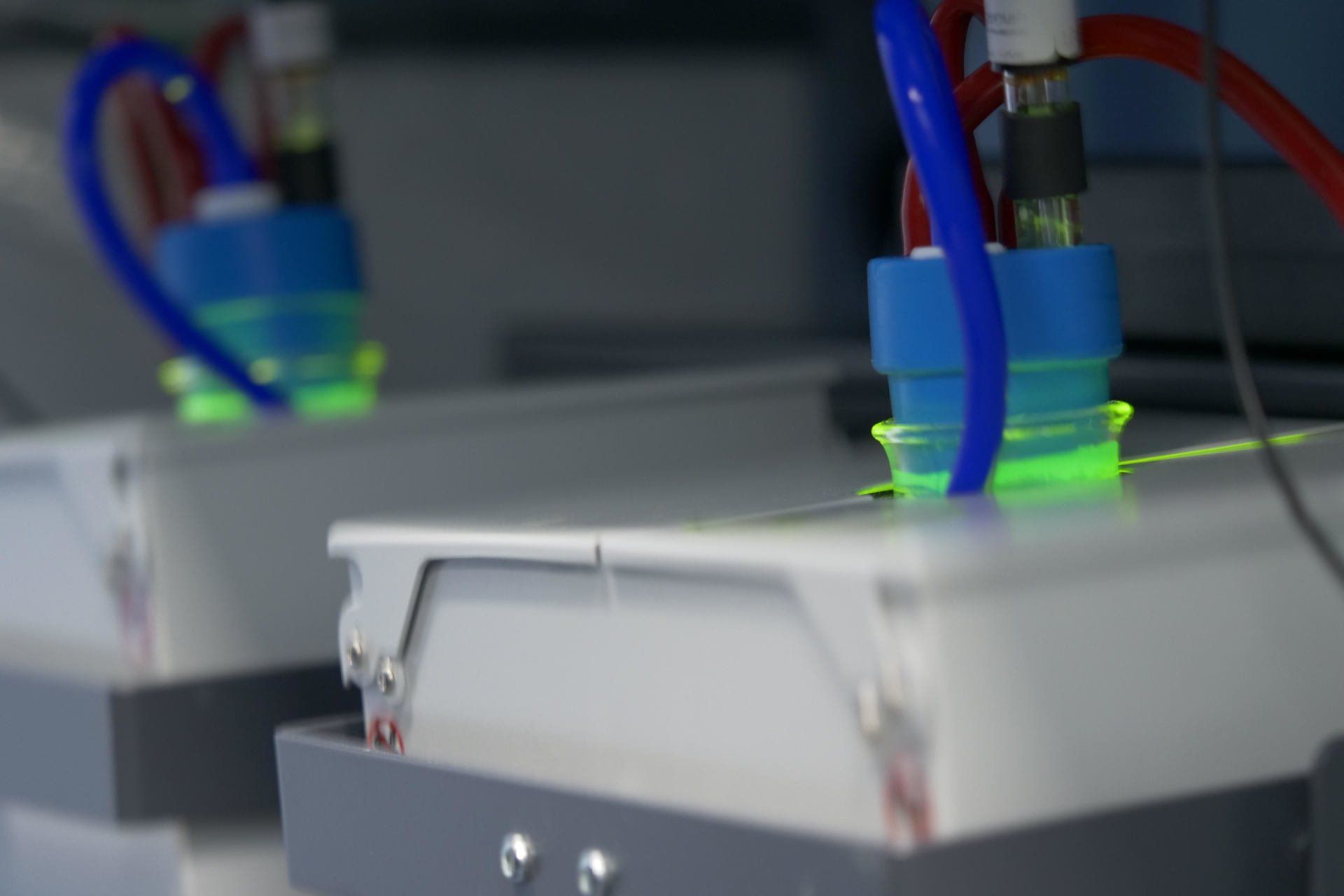Application Notes

Arthrospira platensis (commonly referred to as Spirulina , despite belonging to a morphologically distinct genus) is a filamentous cyanobacterium characterised by its beneficial nutritional content, left handed open helical form, and ability to grow under highly alkaline conditions. A. platensis is protein rich and has been utilised as a traditional foodstuff in multiple cultures, most notably in Central America and in the region surrounding Lake Chad. Recently A. platensis has experienced a resurgence as a health food and a source of the blue pigment phycocyanin for use as a food colourant.

Synechocystis sp . PCC6803 is a unicellular freshwater cyanobacterium commonly employed as a cyanobacterial model system. It is capable of both photo- and heterotrophic growth making it useful for studying photosynthetic processes, and has a well defined circadian clock. Synechocystis sp. PCC6803 is naturally competent allowing direct uptake of recombinant DNA, and has a well defined molecular toolbox including a sequenced genome. There has also been interest in the use of Synechocystis sp. PCC6803 for biofuel applications, both in itself and as a model for other third generation biofuel platforms.

Sampling algal cultures for transcriptomics, proteomics, and enzymatic assays needs to be done quickly and without changing the culturing environment. One common sampling approach is to pause the Algem®, open the Algem® reactor lids, take the Algem® flasks to a laminar flow hood, take the samples, return the flasks to the Algem® reactors, and then resume the Algem® experiment. In most cases, this is a suitable sampling approach. However, one problem with this sampling approach is that the Algem® flask leaves the controlled light and temperature environment of the Algem® reactor and is temporarily exposed to different conditions. Illumination periods of seconds have been demonstrated to have an effect on gene expression (Huysman 2013). In addition, the sampling approach is somewhat time intensive and limits the possibility of sampling every minute or in smaller unit time series.

Chlamydomonas reinhardtii is a motile, unicellular green microalga typically measuring around 10 µm in diameter. It is widely distributed, and is often isolated from soil and freshwater samples. C. reinhardtii has been used as a model organism for over 70 years for both basic and applied research, largely due to its ease of cultivation, rapid doubling time of 6-8 h, and established molecular toolbox (Harris, 2009). Noted areas of study include photosynthesis, phototaxis, cell wall biogenesis, cell cycle events, flagella assembly, mating processes, and nuclear/chloroplast interactions (Rochaix, 1995; Shimogawara et al., 1998; Merchant et al., 2007). Annotated sequences are available for the nuclear, chloroplast and mitochondrial genomes (Merchant et al., 2007, Scaife et al., 2015), and several extensive libraries of mutants have been generated. Transformation of all three genomes have been demonstrated, with nuclear and chloroplast manipulation becoming routine (Boynton et al. 1988; Kindle et al. 1989; Sodeinde and Kindle. 1993). Recently C. reinhardtii has gained attention as a platform for commercial applications; these include recombinant protein expression (Mayfield et al., 2007; Rosales-Mendoza et al., 2012), biohydrogen production (Torzillo et al., 2015), and as a model testbed for biofuel technologies prior to shuttling into more industrially relevant, but less easy to manipulate, biofuel production strains. Cultivation of C. reinhardtii is typically conducted mixotrophically on TAP (tris acetate phosphate) medium. Although suitable for lab-scale work, TAP medium is not appropriate for scale up due to its relatively high cost and susceptibility to contamination.

C. nivalis is a psychrophilic freshwater alga that has adapted to thrive in its own ecological niche within polar and alpine snowfields. The flagellated stages of C. nivalis enable positional change within the snow layer to achieve the required depth for optimal light and temperature conditions. In nature, C. nivalis is most frequently found in the encysted stage (hypnoblast) as this is the lifecycle stage most resistant to environmental changes (Remias et al., 2005). This microalga has been observed to tolerate extreme light, low temperatures (2-10°C) and low nutrient conditions (Remias et al., 2010; 2015). When C. nivalis is cultured under high light and nutrient depletion, it forms mature cysts that are very rigid and difficult to mechanically disrupt (Hoham and Duvel, 2001; Remias et al., 2005). C. nivalis is of commercial interest due to its high antioxidant and phenolic content (Li et al., 2007), in addition to its ability to produce astaxanthin (Rezanka et al., 2008).

The genus Haematococcus is found globally, with reports of isolates from all continents with the exception of Antarctica, with hostile areas of isolation including the artic circle (Klochkova et al., 2013). H. pluvialis is of commercial interest due to its ability to produce copious amounts of astaxanthin, reaching up to 5 % dry weight in the encysted aplanospore state (Wayame et al., 2013). Astaxanthin is sold as a pigment for aquaculture and in animal feed, and is marketed as an antioxidant for the nutraceutical market. The H. pluvialis derived astaxanthin industry is commercially successful; however, several constraints are ever-present including issues of contamination and grazing, high extraction costs, high light requirements for encystment, and conversely, photo-bleaching (Shah et al., 2016). Astaxanthin is produced under high light and nutrient deplete conditions (García-Malea et al., 2008). High temperature is rarely implemented to induce astaxanthin production, as it was reported to severely reduce biomass yield, and thus decrease astaxanthin productivity (Tjahjono et al. 1994). Currently the red stage of astaxanthin production is constrained by biomass production in the green stage, which requires strictly controlled culture conditions. Optimal reported temperatures for the vegetative growth of H. pluvialis are between 20 and 28°C (Wan et al., 2014), with temperatures in excess of 30°C shown to induce transition from the green vegetative stage to the red stage with the formation of aplanospores. Domínguez-Bocanegra et al., (2004) demonstrated optimal growth at an irradiance of 177 µmol photons/m²/s with higher density cultures achieved under continuous light.

P. purpureum is a unicellular red microalga which is found in most terrestrial areas including on submerged river banks and saltmarshes; it is even found within brickwork. Commercial relevance of P. purpureum stems from its high protein content and presence of value-added products including high value polysaccharides, arachidonic acid (ARA) and phycoerythrin (Juin et al., 2015; Su et al., 2016). Its genome was sequenced in 2013 (Bhattacharya et al., 2013). Growth rates and levels of polysaccharides have been found to correlate with light intensity (Valea et al., 2011); however, the effect of light colour on P. purpureum growth is yet to be reported.

G. sulphuraria is an extremophilic, spherical, spore-forming red alga commonly found in hot acid springs. It is an acidophilic and thermophilic alga which grows phototrophically and mixotrophically, and is capable of heterotrophic growth on sugars, alcohols and amino acids (Gross and Schnarrenberger, 1995; Oesterhelt and Gross, 2002; Barbier et al., 2005). G. sulphuraria has commercial potential for wastewater remediation (Schönknecht et al., 2013; Selvaratnem et al., 2014) and the mass production of the phycobiliprotein phycocyanin (Schmidt et al., 2005).

The Algem® software continually receives and records data from the Algem® photobioreactor. This data is normally only accessible via the computer that is connected to the Algem®. However, following this step-by-step guide, the use of file-syncing software enables remote-viewing of live data. In this guide, the software being used is Dropbox®. This approach, however, can be adapted for alternative file-syncing software. It is important to understand that a single folder is created in a designated DropBox account. If your Algem system has multiple users it will be necessary to have a shared DropBox account where individual user results are organized within folders internal to the Algem folder within DropBox.
GET IN TOUCH
to see how our algal and scientific capabilities can transform your application


